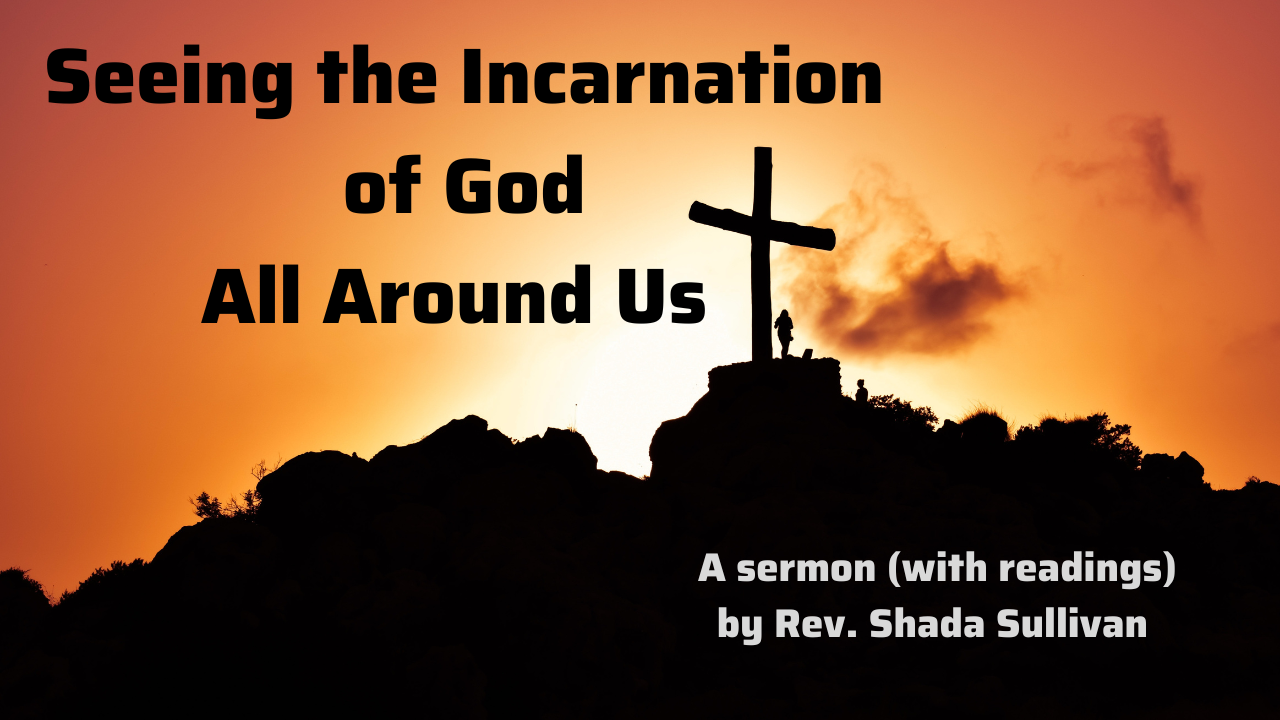|
Readings: Luke 24:44-53, True Christianity #339 (see below)
See also on Youtube Today we hear the conclusion of the Easter story. As it is told in the gospel of Luke, three days after the crucifixion, three women discover the empty tomb and report it to the incredulous disciples. Then, Jesus casually appears to two followers walking on the road to Emmaus and spends some time with them. Finally, Jesus appears to all the gathered disciples, allows them to touch his body, experience its realness, and eats a meal with them. And it is towards the end of this meal that we enter into our text for today. These are the last things that Jesus will do before he leaves. He reaches back to remind the disciples that everything is playing out exactly as he had told them it would, communicating reassurance that the Divine can be trusted, and grounding them in their own scripture and tradition. Then he speaks to them about the future. The disciples were witnesses to a fundamental revealing of God’s nature, and the experience of witnessing such things would change them, and charge them with a new way of living. And then finally, Jesus blesses his beloved friends, and as he is doing so, ascends to heaven. This moment, which we might reasonably assume would be tinged with sadness, is greeted with joy. “And they stayed continually at the temple, praising God.” I don’t know about you, but I feel like if I had been in the disciples shoes, I might have been sad to see Jesus go. A beloved teacher, someone they relied upon, was leaving. Our attachments are not always so easy to release. Our closeness to someone is proportional to how much we will miss them when they are gone. But it also must be noted, that with Jesus gone, the responsibility of the disciples to bear witness was even greater. And this of course, was the plan. Despite being divinely incarnated, Jesus was just one person. One embodiment of Divine Love and Divine Wisdom. And the point was always the existence of Jesus was for the purpose of freeing, empowering and transforming all humanity, each of us. In order to make that happen, Jesus needed to leave. And so we grapple with that reality. There are many ways that Jesus may feel remote to us, and becoming more so. Each day takes us further away from him in time, takes us a little further away culturally from the human society that existed 2000 years ago. And the gospels themselves, they were written by others decades after Jesus left, reflecting the various lenses of the developing Jesus movement just as much (or more) as documenting what actually happened. Yet, somehow, Jesus still speaks. There is something about the shape of his life, his vision, his devotion, his courage that reaches out to us even now. The reaching out of God then took a human shape, a shape that we fundamentally recognize now, a shape that we and everybody we know literally embodies, that we see before us everyday. Despite the fact of the ascension, of his appearing to leave, the fact that our God was a person, even for a relatively few short years so long ago, that God had a body with blood, bones, muscles, organs, had an emotional life with fears, hopes, relationships, and failures, a spiritual life with full of grappling with faith, leadership, being called, and sacrifice, this connects us deeply to Jesus because we recognize something shared and fundamental in the story of his life. As we heard in our reading today, Swedenborg insists on the importance of us believing in a human God, a visible God. And that doesn’t so much mean believing in a God with human foibles, but rather, believing in a God we can relate to on a deep level, with a form that we recognize and with which we feel comfortable. Swedenborg worried that humans beings cannot connect with an abstract God, that this type of God would seem remote and vaporous and therefore would not have any real effectiveness in our emotional and spiritual lives. So he argued that when we think of God as having a human form, as suggested by the incarnation, we will feel deeply understood and affirmed by such a God, we will feel closer to such a God and believe that such a God really wants to be closer to us. We will recognize the ways in which the Divine connects to and infills and enlivens that which is earthly, and so we can believe that the Divine can connect to, infill and enliven us. And this makes a lot of common sense. We will naturally be much more empowered by the God who does not despise our earthliness but rather, willingly took it on, and affirmed it. Which leads to the second point I would like to make about this text today. We started out by thinking about how despite the ascension, the incarnation itself counters the potential remoteness of God with the fact of Jesus’ humanity. And this very naturally prompts us to consider our own humanity, and how it is reflective of the Divine. How we might be called to further and amplify Jesus’ mission in this world. This is indeed a very personal consideration, but that is not all it is. For we note that the gospel does not end with a story of individuality. While earlier accounts post-resurrection highlight the individual experiences of Mary Magdalene, Peter, the two followers on the road to Emmaus, by the time we reach our text for today, Jesus is speaking to all of his disciples… all we hear of is they and them. Jesus was blessing them, they worshiped him and returned to Jerusalem, and they stayed continually at the temple, praising God. There is a reason that Jesus chose twelve and not one. He knew that we would need each other. The human shape of Jesus and his life that deeply connects each of us to him through our own experience, that human shape can also be seen in the way that we connect to each other. Swedenborg writes that in the Lord’s sight, the whole of heaven, and then also each individual heavenly community, reflects the form of a single human being). Human community reflects the beauty, the variety, the inter-dependent differentiation of the human body. And thus, human community is also called to amplify Jesus’ mission, called to create openness that can be filled with God’s spirit, called to work and learn together in a holistic and dynamic way. Other traditions call this the Body of Christ, and we call it the Grand Human, a picture of the way God’s divine humanity permeates the shape of human relationships. And so, on this day that we celebrate the Ascension of Jesus, a day by its very name pictures a God moving away from us, we can know that the opposite is true. The human shape of Jesus was not simply a shell taken upon himself, not a concession, not an accommodation, and certainly not a disguise. The humanity of Jesus was a deep expression of the humanity of God; we were created thus, an image and likeness, and so was Jesus. The image of Jesus as a human being reveals the truth about God and also about ourselves. But to see that, to really really believe it and know it, we cannot fixate upon Jesus or even upon the biblical accounts of his life. Jesus and his story are but one part of God’s gift to us. The rest of the gift is being able to see the ways the shape of Jesus shows up in ourselves and our world. Just like with an optical illusion, when we stare at a particular shape so long that still see its image even when we shift our gaze, Jesus’ ascension gives us a chance to observe the incarnation of God all around us all the time. In ascending, Jesus has given us space to find him again in ourselves, and in each other, and in what we create together. For this blessing we give praise. Amen. (1) Heaven and Hell #59 & #68 Readings: Luke 24:44-53 44 He said to them, “This is what I told you while I was still with you: Everything must be fulfilled that is written about me in the Law of Moses, the Prophets and the Psalms.” 45 Then he opened their minds so they could understand the Scriptures. 46 He told them, “This is what is written: The Messiah will suffer and rise from the dead on the third day, 47 and repentance for the forgiveness of sins will be preached in his name to all nations, beginning at Jerusalem. 48 You are witnesses of these things. 49 I am going to send you what my Father has promised; but stay in the city until you have been clothed with power from on high.” 50 When he had led them out to the vicinity of Bethany, he lifted up his hands and blessed them. 51 While he was blessing them, he left them and was taken up into heaven. 52 Then they worshiped him and returned to Jerusalem with great joy. 53 And they stayed continually at the temple, praising God. True Christianity #339 We are to believe or have faith in God our Savior Jesus Christ because this is believing in a God who can be seen, in whom is what cannot be seen. Faith in a God who can be seen - who is both human and divine at the same time - goes deep within us. Although faith is earthly in its form, it is spiritual in its essence. Within us faith becomes both spiritual and earthly, in that everything spiritual has to be received in what is earthly to become anything to us. Something purely spiritual does indeed enter us but we do not accept it. It is like the ether that flows in and out of us without having any effect. For something to have an effect, we have to be mentally aware of it and open to it. We have no such awareness or openness unless something affects our earthly self.
0 Comments
Leave a Reply. |
Archives
July 2024
Categories |
Wilmington DE 19806
302-654-5014
[email protected]


 RSS Feed
RSS Feed